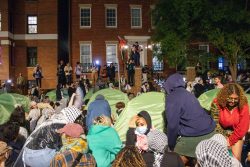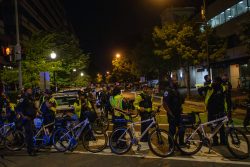Tonight, the D.C. Zoning Commission will begin its final review of Georgetown’s 2010 Campus Plan, the blueprint for the University’s development and growth in the next decade.
As neighborhood groups like the Citizens Association of Georgetown and Advisory Neighborhood Commission 2E have loudly criticized the plan, the University has stepped up its efforts to assuage residents’ concerns. At the beginning of this school year, the University began several quality of life initiatives such as twice-daily trash collection, a new shuttle to M Street, and an increased partnership with the Metropolitan Police Department.
University spokeswoman Stacy Kerr stated that since the beginning of the year, Georgetown has collected around 130 tons of trash. “I think that the facts speak for themselves,” Kerr said. “[Trash collecting] was not anything mandated to us from the city.” If the neighborhood leaders decide trash collecting is not a benefit, they will amend the program accordingly, Kerr added.
The ANC also asserts the new M Street Shuttle has done nothing to mitigate the late-night noise complaints. “I just think those facts don’t show that this is a majority of Georgetown students,” Kerr said. In a meeting last week, MPD notified Georgetown that five of six calls for noise disturbance came from non-student residences.
The ANC report marks a desire for all undergraduate students to move on campus. They suggest that Georgetown can accomplish this by creating new student housing or drawing down the number of students enrolled.
“We disagree with [that] from a fundamental perspective of how we are as students,” said Kerr. “We think our students are mature, and independent enough … to live off campus. We think that’s an important opportunity.”
Kerr cited Georgetown’s recent dropping of a new loop road plan as a clear response to the concerns of its neighbors.
“This is not a zero-sum game,” she said. “It’s not that the University is wrong and the neighbors are right, or the neighbors are wrong and the university is right … it’s a false premise and that’s not where dialogue with our neighbors has proven results.”
This week, Georgetown will distribute a packet to non-student residents with a letter from President DeGioia and a list of the quality of life investments. The packet provides information on the economic contributions Georgetown makes to the city, including the statistic that 40 percent of the University’s employees are D.C. residents.
Several permanent residents in Burleith and in West Georgetown, like Meg Moran, said that the presence of students was noticeable during the weekends. Moran has a young family, with kids running around the house. But she came to Burleith with full knowledge that she was moving in next to a college. “We knew what we were buying into,” she said.
Tim Tinsley, who has lived in Georgetown for three and a half years, said he felt the late night disturbances had decreased over the last year and a half. “Occasionally there is silly damage, usually after Saturday nights,” said Tinsley. “We don’t leave out flower pots.”
James Caroll, a former Georgetown professor and resident of Georgetown for 30 years, said he has seen the development of the University’s neighborhood relations. Caroll blamed both the University and the neighbors for the building tension.
“The University has seemed blind or incapable of working with people,” he said. He cited programs like the Osher Lifelong Learning Institute at American University as examples of a university working constructively with its community. “Georgetown has no similar program or no educational activities geared to the population around the University,” Caroll said.
He added that another barrier to community interaction with the school is the difficulty of finding out about events going on around campus.
“My wife and I would like to go to the Davis Center but the website is lousy,” Caroll said. Meanwhile, he said that CAG had become a vehicle for criticizing the University. “I know and you know there is not that much more room on campus,” he said. “[It’s a] political power and human relations problem.”
Other universities have fared better in their relationships with neighbors. According to Lauren Marshall, the Public Information Officer at Harvard University, the school has a strong partnership with the city of Cambridge.
“[We] are actively engaged with City leaders and our neighbors on a variety of issues that address our mutual goal of supporting the quality of life in Cambridge,” Marshall wrote in an email. “Our… partnership with Cambridge has served to enhance public education, increase the supply of affordable housing, create and support a vibrant local economy, and support non-profit social service organizations that serve our community.”
She also attributes the positive town-gown relations to Harvard’s long history with the community. “Harvard has been a part of the fabric of Cambridge of 375 years,” wrote Marshall. “Our past, as well as our future, are intertwined.”




